Regular HJ Field Cap
CATEGORY: Version
SKU: 31.GOR.01.01.03.001.000
Estimated market value:
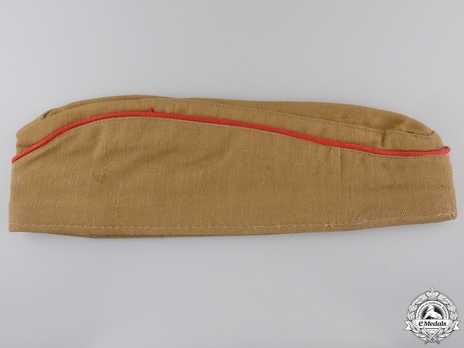
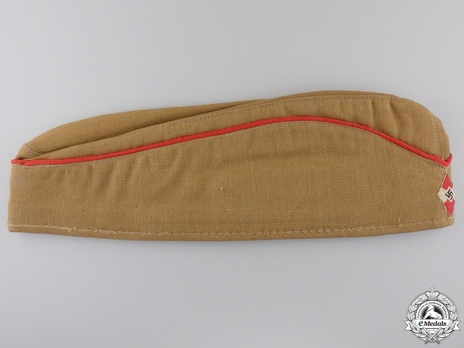
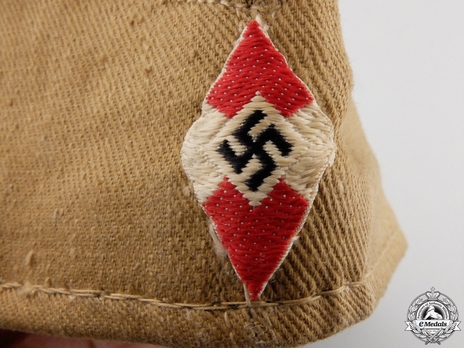
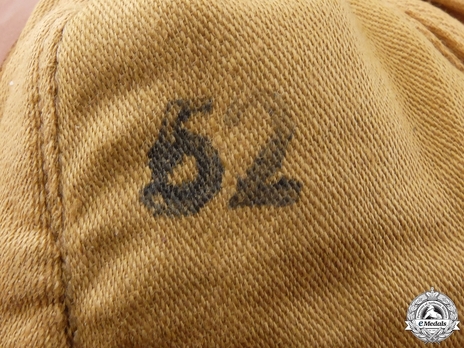
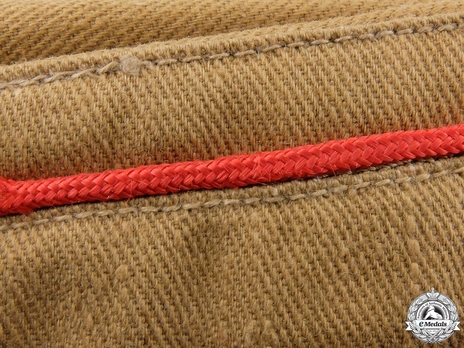
Estimated market value:
Fabricated from light brown cotton, with red piping on the exterior, a red, white and black embroidered HJ insignia on the front, inside with a 35 mm wide synthetic leather sweatband, label sewn in place under the sweatband, the label marked with the RZM (Reichszeugmeisterei) insignia, inscribed "SOMMER-MÜTZE Nach Vorschrift der RJF" (summer hat as specified by the RJF), "Hersteller" (manufacturer) and stamped "27" (manufacturer's number), "Reichszeugmeisterei der NSDAP" and number stamped "No 098884", size stamped in black ink "52" in the dome, measuring 75 mm x 260 mm, the exterior with one small soiling mark on the left side, the sweatband exhibiting crazing and wear, the stitching remaining intact throughout, very clean, better than very fine.
The Feldmütze was introduced in the so-called “Schiffchen” form (overseas style) on January 31, 1936, under the name of “HJ-Lagermütze” (camp cap), but it was renamed to “HJ-Feldmütze” (field cap) later that year.
The cap was only allowed to be worn in camp or in a youth hostel, and it was worn by non-commissioned ranks of the Regular HJ. From July 1937 onward, the “Feldmütze” was also worn by the DJ (Deutsches Jungvolk = German Youngsters).
As of April 30, 1937, the Field Cap was supposed to be worn with the Großer HJ-Dienstanzug (HJ formal service dress), as opposed to the Service Cap, which was to be worn with the Kleiner HJ-Dienstanzug (HJ informal service dress).
It was worn during the summer months (Apr 15th until Oct 14th), which is why it is also known as the Summer Cap. It was primarily composed of light brown/khaki cloth with red piping on the turn-up. The inside of the caps often feature a sewn-in RZM (Reichszeugmeisterei) control tag as a sign of legitimization.
The cap sported the HJ diamond on the front of the turn-up with the national emblem above; both could be composed of metal or cloth up until September 30, 1938. From September 30, 1938 until 1939, the national emblem was made from cloth, and the HJ diamond was composed of metal. After 1939/1941 the national emblem was removed from the cap, and by May 30, 1942, the diamond was only composed of cloth.
After April 30, 1937/April 9, 1938, the colour of the piping was no longer restricted to red, instead it was determined by the wearer's branch-of-service, including white (1937), pink, light blue, yellow, carmine, and green (all 1938).
White piping was added to the caps of HJ members with specialized training at the NPEA (Nationalpolitische Erziehungsanstalt) (National Political Education Institutes).
Pink piping was added to the caps of HJ members of the Motor-HJ (Motorized) subdivision.
Light blue piping is known to have been added to the caps of HJ members of the Flieger-HJ (Aviation) subdivision.
Yellow piping was added to the caps of HJ members of the Nachrichten-HJ (Signal) subdivision.
Green piping was added to the caps of HJ members of the Landjahr (Land Year) subdivision.
A dark navy blue version of the cap was worn by members of the Marine-HJ (Naval) subdivision with their summer work uniform. The regulations from 1944 state that gold-coloured cord would be added at the top edge of the turn-up.
Also during the visit to Japan in 1939, a cap in the Feldmütze style, but in dark blue or black with white piping, was worn by non-leaders of the HJ.
Additionally, Hitler Youth members of the volunteer fire fighting service wore the cap in Prussian blue with carmine piping. Some volunteers, however, wore a standard pattern black cap with machine-woven white on black police insignia.

Comments
Sign in to comment and reply.


Scroll Top